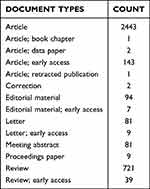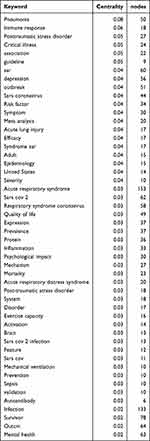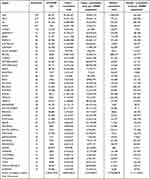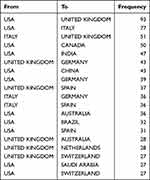Back to Journals » Journal of Multidisciplinary Healthcare » Volume 17
A Bibliometric Analysis of Post-COVID-19 Syndrome
Authors Liu H , Li Z, Yan S, Ming S
Received 7 May 2024
Accepted for publication 23 August 2024
Published 29 August 2024 Volume 2024:17 Pages 4213—4221
DOI https://doi.org/10.2147/JMDH.S477256
Checked for plagiarism Yes
Review by Single anonymous peer review
Peer reviewer comments 2
Editor who approved publication: Prof. Dr. Krzysztof Laudanski
Hongtao Liu,1 Zhaoyu Li,2 Su Yan,2 Shaopeng Ming2
1Clinical Medical School, Guangxi Health Science College, Nanning, People’s Republic of China; 2Anesthesiology Department, The Second Affiliated Hospital of Guangxi Medical University, Nanning, People’s Republic of China
Correspondence: Shaopeng Ming, Anesthesiology Department, The Second Affiliated Hospital of Guangxi Medical University, Nanning, 530011, People’s Republic of China, Email [email protected]
Objective: The goal of this study is to explore the research advancements on Post-COVID-19 syndrome, through bibliometric analysis, thus summarizing our current comprehension of the subject and suggesting directions for future research strategies.
Methods: We acquired literature data from the Web of Science Core Collection (WoSCC) and conducted keyword and country analyses utilizing CiteSpace and R-project tools.
Results: Until November 2, 2022, a total of 3633 publications were cataloged from WoSCC. The key terms commonly associated with Post-COVID-19 syndrome symptoms included: immune response, posttraumatic stress disorder, depression, acute lung injury, mental health, and quality of life. The United States emerged as leading in both producing the most research and fostering international cooperation. It was observed that the output of publications from a country is directly proportional to the cumulative number of COVID-19 cases and deaths therein.
Conclusion: Utilizing bibliometric analysis, the study highlights the detrimental impact of mental health issues on Post-COVID-19 patients’ quality of life, emphasizing the urgency for further research and treatment. The sheer scale of COVID-19 cases underscores this need, while international collaboration emerges as a pivotal tool for advancing our understanding and addressing this challenge.
Keywords: bibliometrics, Post-COVID-19 Syndrome, mental health
Introduction
Since its inaugural outbreak in late 2019, the novel coronavirus (COVID-19) rapidly escalated into a global pandemic, infecting hundreds of millions across the globe and leading to millions of fatalities. Despite the containment of virus transmission in certain regions owing to the development and mass administration of vaccines, long-term effects of COVID-19 have started to surface. Post-COVID-19 Syndrome, a significant public health concern, has introduced new challenges to the global healthcare system.1
Post-COVID-19 syndrome encompasses an array of persistent effects post-initial COVID-19 infection, the symptoms of Post-COVID-19 syndrome are diverse and multifaceted, encompassing various systems including, but not limited to, respiratory (such as dyspnea, cough, and shortness of breath), cardiovascular (including chest pain, myocarditis, and pericarditis), musculoskeletal (manifesting as weakness, myalgia, and joint pain), neurological and mental health (encompassing sleep disturbances, headaches, memory loss, cognitive difficulties, depression, anxiety, dizziness upon standing, paresthesia, and loss of smell or taste), and digestive (like diarrhea and abdominal pain). Furthermore, patients may experience systemic symptoms such as exacerbated fatigue, fever, post-exertional malaise, and chronic fatigue akin to Chronic Fatigue Syndrome (CFS). Additionally, more severe complications may arise, such as thrombosis, alopecia, and chronic kidney disease, all of which significantly impact patients’ daily lives and overall health status.2,3 These sequelae may arise directly from the biological aftermath of the infection or indirectly due to the stress exerted by the infection on other physiological systems.
While recent research has started to emphasize Post-COVID-19 syndrome, our comprehension of this disease remains nascent, particularly lacking in-depth investigations into its pathogenesis, longer-term health impacts, and effective treatment approaches.
Bibliometrics is a scientific methodology that scrutinizes the quantity, quality, distribution, and impact of scientific literature. It integrates the principles and techniques of metrology, statistics, and information science, aiming to unveil trends and dynamics in scientific research through the quantification and analysis of multiple characteristics and parameters nested in scientific literature.4
Hence, this study endeavors to examine the research advancements on Post-COVID-19 syndrome in extant literature, using bibliometric analysis to compile our present understanding of it and propose directions for prospective research and strategic initiatives.
Materials and Methods
Data Acquisition
A literature search was conducted within the Web of Science Core Collection (WoSCC), using “Post-COVID-19 Syndrome” as the search term. Given the onset of the global COVID-19 outbreak in 2019, December 2019 was set as the start date, moving up to the end date, which aligned with the completion of this study - November 2, 2022. Upon collecting the relevant literature, all retrievals were exported before utilizing CiteSpace 5.6.R15 to exclude any duplicate publications.
Subsequently, we will gather COVID-19 related data from the World Health Organization’s (WHO) official website (https://www.who.int/data/sets/global-excess-deaths-associated-with-covid-19-modelled-estimates). This data provides information about the number of confirmed COVID-19 cases and resultant fatalities across various countries worldwide - accurate up to November 2, 2022.
Bibliometrics Analysis
We utilized CiteSpace 5.6.R1 for keyword analysis, encompassing aspects such as keyword co-occurrence, clustering, and timeline analysis, with the results being visualized. A bibliometric analysis related to various countries was conducted using the R-project (4.2.3) software6 enclosed with the bibliometrix package.7 This was accompanied by analysis of keywords most relevant to Post-COVID-19 syndrome. Lastly, we engaged a correlation analysis between the science production by country and parameters such as the number of COVID-19 cases, deaths, as well as the Gross Domestic Product (GDP) for 2021. Pearson correlation analysis was performed using R-project (4.2.3), and the outcomes were then visualized using the pheatmap package.8
Results
Search Results
As of November 2, 2022, a total of 3633 publications were identified within the WoSCC database. In the search results, British scientist Robert M Barker-Davies pioneered the earliest publication elucidating Post-COVID-19 syndrome in August 2020.9 Details pertaining to the types of each document can be found in Table 1. The trends in annual production are displayed in Figure 1.
 |
Table 1 Details of Each Document Types |
 |
Figure 1 The trends in annual production. |
Keyword Analysis
From the collected literature, a total of 347 keywords were extracted. The top 50 keywords, based on centrality, are tabulated in Table 2 and graphically represented in Figure 2a. Bibliometrics utilizes keyword centrality as an indicator for measuring the significance and influence of keywords within a literature network. It examines keyword dispersion as well as their connectivity within a literature database, uncovering relationships between various keywords and thereby evaluating their central role within a given research field.10 Through this process, we identified pivotal terms associated with Post-COVID-19 syndrome symptoms, such as immune response, posttraumatic stress disorder, depression, acute lung injury, mental health, and quality of life.
 |
Table 2 Top 50 Keywords for centrality.The Larger the Value Represent the Higher the Centrality |
 |
Figure 2 Keywords analysis. (a) Keywords co-occurrence (b) Keywords clustering (c)Trend Topics. |
Cluster analysis consolidated collected keywords into five categories, represented in Figure 2b. The key terms for each cluster were identified as SARS-CoV-2, post-intensive care syndrome, mental health, long COVID, vaccination, and public health.
Furthermore, the analysis of trending topics showed that scientists began to focus on Post-COVID-19 syndrome (long COVID) from 2021 onwards, as demonstrated in Figure 2c.
Country Analysis
Based on the count of publications over the last three years, the top ten contributing countries are the USA, Italy, UK, India, China, Germany, Spain, France, and Australia (Table 3 and Figure 3a). Analyzing collaborations between countries, we observed robust cooperation amongst nations experiencing more severe pandemic conditions (Table 4 and Figure 3b). The citation count serves as an indicator of a publication’s impact and significance. The higher the citation count, the greater the work’s influence within the academic community, highlighting its value as a research output or reference. The citation count can also be utilized as an evaluative measure for academic research accomplishments.11 Citation analysis revealed that publications from the USA, UK, China, Italy, and other prolific contributors hold substantial significance. This prominence is also influenced by the high volume of publications originating from these countries (Figure 3c).
 |
Table 3 Details of Countries with More Than 10 Publications |
 |
Table 4 The Top 20 Groups of Countries with the Most Collaboration |
 |
Figure 3 Country analysis. (a)Country Scientific Production (b) Country Collaboration (c) Country Scientific Production cited (d) Correlation analysis. |
Subsequently, in the correlation test, we discovered a positive correlation between country-based publications and the cumulative number of COVID-19 cases and deaths in each country. However, no correlation was found between the GDP of each country and the COVID-19 death rate per 100,000 (Table 3 and Figure 3d).
Discussion
The surge in research on Post-COVID-19 syndrome, also known as long COVID, as identified by our bibliometric analysis (Figure 1), signals its mounting recognition and concern within the scientific community. This growth in scientific output parallels the rising real-world prevalence of Post-COVID-19 syndrome, a multidimensional condition that continues to impact patients well beyond their initial recovery.12 Notably, from 2021 onwards, as the COVID-19 pandemic showed signs of ease, researchers devoted increased attention to the mechanisms and treatments of Post-COVID-19 syndrome, leading to a steady year-on-year growth in research accomplishments (Figure 1).
Keyword analysis indicates that researchers are placing significant emphasis on studies related to the quality of life of COVID-19 patients. Studies have illustrated that Post-COVID-19 syndrome exhibits a myriad of symptoms and impacts diverse organ systems, reinforcing the complexity of the condition,13–15 Mental health issues, common symptoms of Post-COVID-19 syndrome, substantially affect patients’ quality of life,16,17 warranting their focused attention by researchers. Correspondingly, in the cluster analysis, a considerable quantity of research targets mental health concerns. Key persistent symptoms associated with Post-COVID-19 syndrome such as sleep disturbances, depression, post-traumatic stress disorder, brain fog, and other psychiatric symptoms profoundly impact patients’ quality of life. However, the roots of these long-term symptoms remain ill-defined.18 Hence, the mechanistic understanding and treatment of Post-COVID-19 syndrome-associated mental health problems are expected to continue as the focal points of research for the foreseeable future.
From our analysis of three years’ worth of literature, it appears that the United States holds a leading position in scientific production on Post-COVID-19 syndrome, followed by Italy, the United Kingdom, India, and China. Concurrently, these countries also report some of the highest numbers of COVID-19 patients worldwide. It is widely accepted that disease research necessitates a certain number of cases as a baseline, particularly for novel and poorly understood diseases. When the number of affected individuals crosses a specific threshold, it induces research interest. However, scientific production does not correlate directly with a country’s economic strength (GDP), as depicted in Figure 3d—but primarily, with the level of national attention dedicated to the disease. Nonetheless, it’s not entirely accurate to interpret the study’s results in this manner. Given the global devastation of COVID-19, all countries are likely to invest heavily in research related to the virus, regardless of financial constraints.
International collaboration has emerged as a vital avenue for current disease research. Our study results highlight the prominence of the United States leading Post-COVID-19 syndrome research, along with a notable level of collaboration between countries with high COVID-19 caseloads or global influence. These findings unravel interesting facets of international cooperation in the context of Post-COVID-19 syndrome research (Figure 3). Primarily, the dominant contribution of the United States to COVID-19 research may mirror its superior standing in medical research, coupled with its abundant research resources. The nation boasts prestigious universities, research institutes, and medical centers that draw top-tier scientists and research groups globally. Moreover, factors such as the level of research investment and a favorable policy environment may have bolstered the United States’ pioneering role in Post-COVID-19 syndrome research. Secondly, the severity of the COVID-19 pandemic potentially fosters closer collaboration between nations with high COVID-19 caseloads or major countries, propelling research. Such cooperation facilitates information and resource sharing, accelerating our understanding of Post-COVID-19 syndrome and the generation of potential solutions. Moreover, the pandemic’s broad scale and complexity may impel nations to pursue transnational cooperation to effectively tackle shared challenges.
Limitations
Nonetheless, this study presents some limitations. Bibliometrics primarily rely on published academic manuscripts, but not all research findings end up published. As a result, bibliometrics may not wholly represent the entire scope of scientific research. Furthermore, this study exclusively considers literature from the WOSCC database. Although WOSCC incorporates high-caliber literature, it does not necessarily encompass all high-level investigations. Additionally, due to the nascent stage of this study, the literature from the year 2023 is not included.
Conclusion
This study, utilizing bibliometric analysis, underscores the profound impact of mental health issues on the quality of life among Post-COVID-19 syndrome patients, highlighting these concerns as essential areas for future research and therapeutic interventions. The vast expanse of COVID-19 cases underscores the urgency and significance of such endeavors. Moreover, the study reflects upon the critical role of international collaboration in advancing our understanding and addressing this multifaceted challenge. As we move forward, it is imperative to not only deepen our scientific inquiry but also foster cross-border partnerships to expedite the development of effective strategies for mitigating the mental health burden associated with Post-COVID-19 syndrome.
Funding
2020 Guangxi Medical and Health Appropriate Technology Development and Application Program, that is study on the protective effect of dexmedetomidine in perioperative patients undergoing kidney transplantation (Grant No. S2020014) and the other is the Guangxi Medical and health key discipline construction project.
Disclosure
The authors report no conflicts of interest in this work.
References
1. Lechner-Scott J, Levy M, Hawkes C, Yeh A, Giovannoni G. Long COVID or post COVID-19 syndrome. Mult Scler Relat Disord. 2021;55:103268. doi:10.1016/j.msard.2021.103268
2. Ceban F, Ling S, Lui LMW, et al. Fatigue and cognitive impairment in Post-COVID-19 Syndrome: a systematic review and meta-analysis. Brain Behav Immun. 2022;101:93–135. doi:10.1016/j.bbi.2021.12.020
3. Premraj L, Kannapadi NV, Briggs J, et al. Mid and long-term neurological and neuropsychiatric manifestations of post-COVID-19 syndrome: a meta-analysis. J Neurol Sci. 2022;434:120162. doi:10.1016/j.jns.2022.120162
4. Hood WW, Wilson CS. The Literature of Bibliometrics, Scientometrics, and Informetrics. Scientometrics. 2001;52(2):291. doi:10.1023/A:1017919924342
5. Chen C. Searching for intellectual turning points: progressive knowledge domain visualization. Proc Natl Acad Sei. 2004;101(1):5303–5310. doi:10.1073/pnas.0307513100
6. Dessau RB, Pipper CB. R--project for statistical computing. Ugeskr Laeger. 2008;170(5):328–330.
7. Arruda H, Silva ER, Lessa M, Proença Jr. D Jr, Bartholo R. VOSviewer and Bibliometrix. J Med Libr Assoc. 2022;110(3):392–395. doi:10.5195/jmla.2022.1434
8. Moazam M [R] Please help with creating the improved image with pheatmap package.
9. Barker-Davies RM, O’Sullivan O, Senaratne KPP, et al. The Stanford Hall consensus statement for post-COVID-19 rehabilitation. Br J Sports Med. 2020;54(16):949–959. doi:10.1136/bjsports-2020-102596
10. Uddin S, Khan A. The impact of author-selected keywords on citation counts. J Informetrics. 2016;10(4):1166–1177. doi:10.1016/j.joi.2016.10.004
11. Nazir S, Asif M, Ahmad S, Bukhari F, Afzal MT, Aljuaid H. Important citation identification by exploiting content and section-wise in-text citation count. PLoS One. 2020;15(3):e0228885. doi:10.1371/journal.pone.0228885
12. Rabah RA, Qushnood F, Doddamani GB. Post COVID-19 Syndrome- A Long Hauling Journey Ahead. Science Publish Group. 2021(5).
13. Lucia U, Grisolia G, Deisboeck TS Thermodynamics and SARS-CoV-2: neurological effects in post-Covid 19 syndrome; 2021.
14. Dennis A, Wamil M, Alberts J, Oben J, Banerjee A. Multiorgan impairment in low-risk individuals with post-COVID-19 syndrome: a prospective, community-based study. BMJ open. 2021;11(3):e048391. doi:10.1136/bmjopen-2020-048391
15. Gasecka A, Pruc M, Kukula K, et al. Post-COVID-19 heart syndrome. Cardiol j. 2021(2).
16. De Berardis D, Di Carlo F, Di Giannantonio M, Pettorruso M, Pettorruso DDBDCDG. Legacy of neuropsychiatric symptoms associated with past COVID-19 infection: A cause of concern. World J Psych. 2022;12(6):773–778. doi:10.5498/wjp.v12.i6.773
17. Delanerolle G, Zeng Y, Shi JQ, et al. Mental health impact of the Middle East respiratory syndrome, SARS and COVID-19: A comparative systematic review and meta analysis. World J Psych. 2022;005:012.
18. Malik P, Patel K, Pinto C, et al. Post-acute COVID-19 syndrome (Post-COVID-19 syndrome) and health-related quality of life (HRQoL)-A systematic review and meta-analysis. J Med Virol. 2022;94(1):253–262. doi:10.1002/jmv.27309
 © 2024 The Author(s). This work is published and licensed by Dove Medical Press Limited. The
full terms of this license are available at https://www.dovepress.com/terms.php
and incorporate the Creative Commons Attribution
- Non Commercial (unported, 3.0) License.
By accessing the work you hereby accept the Terms. Non-commercial uses of the work are permitted
without any further permission from Dove Medical Press Limited, provided the work is properly
attributed. For permission for commercial use of this work, please see paragraphs 4.2 and 5 of our Terms.
© 2024 The Author(s). This work is published and licensed by Dove Medical Press Limited. The
full terms of this license are available at https://www.dovepress.com/terms.php
and incorporate the Creative Commons Attribution
- Non Commercial (unported, 3.0) License.
By accessing the work you hereby accept the Terms. Non-commercial uses of the work are permitted
without any further permission from Dove Medical Press Limited, provided the work is properly
attributed. For permission for commercial use of this work, please see paragraphs 4.2 and 5 of our Terms.

